The high temperature heat pump dryers market is projected to expand from USD 1,567 million in 2025 to USD 2,147.1 million by 2035, growing at a CAGR of 3.2% over the forecast period. Regional dynamics show differentiated growth patterns, reflecting industrial capacity, energy efficiency targets, and technological adoption across key economies. In North America, the demand is strongly supported by regulatory frameworks promoting energy efficiency in industrial operations. The United States leads adoption in sectors such as petrochemicals, food processing, and power generation, where rising operational costs are pushing operators toward advanced thermal drying solutions. The integration of smart energy management platforms and heat recovery technologies is anticipated to drive long-term adoption.
In Europe, growth is reinforced by industrial sustainability policies and stringent energy directives, with Germany, France, and the UK at the forefront of deploying heat pump dryers in manufacturing and utility sectors. Adoption in the EU is further supported by strong R&D programs and the development of renewable heat integration with industrial dryers, making the region an early mover in adopting hybrid thermal systems. Asia Pacific represents the fastest-growing region, supported by expanding industrial infrastructure in China, India, Japan, and South Korea. The surge in manufacturing, combined with high energy consumption in textile, electronics, and chemicals, is driving rapid uptake. China’s large-scale industrial modernization and India’s increasing push toward energy-efficient industrial technologies are creating strong growth momentum.
The Middle East and Africa, though smaller in scale, are showing rising interest due to the petrochemical and energy sector’s demand for efficient thermal processing systems. Gulf economies are investing in energy-efficient technologies to improve process optimization, while African nations are seeing gradual adoption in food processing and agricultural drying. Latin America demonstrates steady demand, particularly in Brazil and Mexico, where energy-intensive industries are integrating heat pump dryers to reduce operational costs.
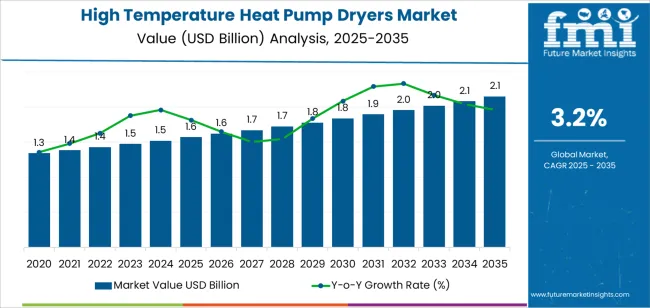
Where revenue comes from -- now vs next (industry-level view)
| Period | Primary Revenue Buckets | Share | Notes |
|---|---|---|---|
| Today | Air source heat pump dryers (industrial, commercial) | 62% | Traditional applications, established facilities |
| Water source heat pump systems | 31% | High-efficiency operations, specialized applications | |
| Ground source & hybrid systems | 7% | Premium installations, energy-intensive operations | |
| Future (3-5 yrs) | Advanced air source systems | 55-58% | Enhanced efficiency, smart controls |
| High-capacity water source systems | 23-26% | Industrial complexes, large-scale operations | |
| Power industry applications | 14-17% | Coal plants, renewable facilities | |
| Petrochemical processing applications | 8-12% | Chemical plants, refining operations | |
| Environmental protection systems | 6-10% | Waste processing, emission control | |
| Custom & specialty applications | 4-7% | Water conservancy, specialized industries |
High Temperature Heat Pump Dryers Market Key Takeaways
| Metric | Value |
|---|---|
| Market Value (2025) | USD 1,567 million |
| Market Forecast (2035) | USD 2,147.1 million |
| Growth Rate | 3.2% CAGR |
| Leading Heat Source | Air Source Heat Pumps |
| Primary Application | Power Industry Segment |
The high temperature heat pump dryers market demonstrates strong fundamentals with air source heat pump systems capturing a dominant share through advanced thermal efficiency and industrial application optimization. Power industry applications drive primary demand, supported by increasing energy efficiency requirements and industrial facility modernization initiatives. Geographic expansion remains concentrated in developed markets with established industrial infrastructure, while emerging economies show accelerating adoption rates driven by manufacturing modernization initiatives and rising environmental standards.
Offer complete thermal systems: heat pump units + control systems + recovery equipment + monitoring systems + installation guides + maintenance protocols.
Primary Classification: The high temperature heat pump dryers market segments by heat source type into air source, water source, and ground source systems, representing the evolution from traditional thermal processing to sophisticated heat recovery technologies for comprehensive industrial drying optimization.
Secondary Classification: Application segmentation divides the high temperature heat pump dryers market into power industry, petrochemical, environmental protection, water conservancy, and others, reflecting distinct requirements for thermal performance, efficiency standards, and process integration specifications.
Tertiary Classification: End-use segmentation covers power plants, chemical facilities, manufacturing plants, waste treatment facilities, and research institutions, while distribution channels span direct sales, system integrators, and specialized industrial equipment suppliers.
Regional Classification: Geographic distribution covers North America, Latin America, Western Europe, Eastern Europe, East Asia, South Asia Pacific, and Middle East & Africa, with developed markets leading adoption while emerging economies show accelerating growth patterns driven by industrial modernization programs.
The segmentation structure reveals technology progression from traditional thermal processing toward sophisticated heat pump systems with enhanced energy recovery capabilities, while application diversity spans from power generation to specialized industrial processing requiring precision thermal solutions.
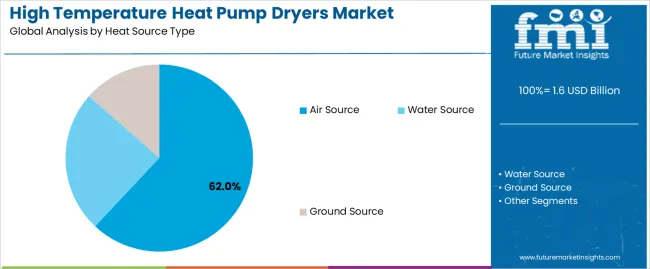
Market Position: Air source heat pump systems command the leading position in the high temperature heat pump dryers market with 62% market share through proven thermal technologies, including efficient heat exchange, reliable operation characteristics, and industrial performance optimization that enable manufacturing operators to achieve optimal energy efficiency across diverse industrial and commercial environments.
Value Drivers: The segment benefits from industrial facility preference for versatile heat pump systems that provide consistent thermal performance, operational reliability, and energy efficiency without requiring specialized infrastructure. Advanced air source processing features enable enhanced heat recovery, precise temperature control, and integration with existing industrial systems, where energy performance and process reliability represent critical operational requirements.
Competitive Advantages: Air source heat pump systems differentiate through proven efficiency reliability, versatile installation characteristics, and integration with established industrial management systems that enhance facility effectiveness while maintaining optimal energy standards suitable for diverse thermal applications.
Key market characteristics:
Water Source Shows High-Efficiency Market Position
Water source heat pump systems maintain a 31% market position in the high temperature heat pump dryers market due to their superior efficiency advantages and specialized application benefits. These systems appeal to facilities requiring high-capacity thermal solutions with enhanced performance profiles for large-scale operations. Market growth is driven by industrial complex expansion, emphasizing high-efficiency thermal solutions and operational excellence through optimized heat transfer designs.
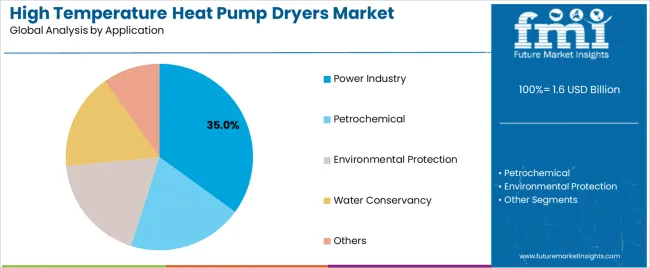
Market Context: Power industry applications demonstrate strong growth in the high temperature heat pump dryers market with 7.1% CAGR due to widespread adoption of energy-efficient thermal systems and increasing focus on operational excellence, energy cost reduction, and process optimization applications that maximize thermal effectiveness while maintaining power generation standards.
Appeal Factors: Power industry operators prioritize system reliability, energy efficiency, and integration with existing power infrastructure that enables coordinated thermal operations across multiple generation units. The segment benefits from substantial power industry investment and modernization programs that emphasize the acquisition of advanced thermal systems for efficiency optimization and emission reduction applications.
Growth Drivers: Power plant modernization programs incorporate heat pump dryers as essential components for thermal operations, while renewable energy growth increases demand for thermal capabilities that comply with efficiency standards and minimize operational complexity.
Market Challenges: Varying plant configurations and operational scale complexity may limit system standardization across different power facilities or generation scenarios.
Application dynamics include:
Petrochemical Applications Maintain Specialized Demand
Petrochemical applications capture 26% market share through specialized processing requirements in chemical plants, refining facilities, and industrial applications. These facilities demand high-performance thermal systems capable of supporting process requirements while providing energy efficiency access and operational reliability capabilities.
Environmental Protection Applications Show Regulatory Growth
Environmental protection applications account for 19% market share, including waste treatment facilities, emission control systems, and regulatory compliance operations requiring performance thermal capabilities for environmental optimization and operational effectiveness.
Market Context: Power Plants dominate the high temperature heat pump dryers market with 6.8% CAGR, reflecting the primary demand source for high temperature heat pump dryer technology in energy applications and operational optimization.
Business Model Advantages: Power Plants provide direct market demand for standardized thermal systems, driving volume production and cost optimization while maintaining efficiency control and performance consistency requirements.
Operational Benefits: Power Plant applications include energy optimization, operational efficiency, and performance assurance that drive consistent demand for thermal systems while providing access to latest heat pump technologies.
| Category | Factor | Impact | Why It Matters |
|---|---|---|---|
| Driver | Industrial energy efficiency requirements & cost reduction (energy prices, regulatory compliance) | ★★★★★ | Growing industrial market requires efficient thermal systems with enhanced energy recovery capabilities and cost reduction properties proven effective across manufacturing applications. |
| Driver | Environmental regulations advancement & emission standards (carbon reduction, efficiency mandates) | ★★★★★ | Transforms thermal requirements from "basic processing" to "efficient energy management"; operators that offer advanced thermal systems and compliance features gain competitive advantage. |
| Driver | Industrial modernization & process optimization (facility upgrades, technology advancement) | ★★★★☆ | Modern industrial facilities need sophisticated, high-efficiency thermal systems; demand for advanced and integrated thermal solutions expanding addressable market. |
| Restraint | High initial investment & capital constraints (especially for smaller facilities) | ★★★★☆ | Smaller industrial operators defer thermal system upgrades; increases price sensitivity and slows advanced thermal adoption in cost-conscious markets. |
| Restraint | Alternative thermal technology competition (conventional dryers, other heat recovery systems) | ★★★☆☆ | Traditional thermal alternatives offer established supply chains and lower costs, potentially limiting heat pump dryer adoption in conventional applications. |
| Trend | Heat pump technology integration & performance enhancement (smart controls, energy analytics) | ★★★★★ | Advanced thermal properties, efficiency optimization, and performance analytics transform operations; technology integration and performance enhancement become core value propositions. |
| Trend | Digitization & IoT connectivity (remote monitoring, predictive maintenance) | ★★★★☆ | Smart thermal systems for specific applications and processes; specialized monitoring and targeted optimization capabilities drive competition toward digital solutions. |
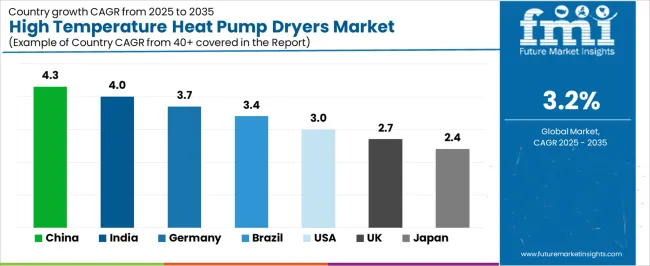
| Region/Country | 2025-2035 Growth | How to win | What to watch out |
|---|---|---|---|
| China | 4.3% | Focus on cost-effective manufacturing solutions | Regulatory changes; local competition |
| India | 4% | Lead with energy-efficient systems | Import restrictions; infrastructure barriers |
| Germany | 3.7% | Provide premium efficiency systems | Over-regulation; lengthy approvals |
| Brazil | 3.4% | Offer value-oriented solutions | Currency fluctuations; import duties |
| United States | 3% | Push technology integration | Compliance costs; scaling challenges |
| United Kingdom | 2.7% | Focus on efficiency applications | Economic impacts; energy costs |
| Japan | 2.4% | Emphasize precision manufacturing | Traditional preferences; adoption rates |
The high temperature heat pump dryers market demonstrates varied regional dynamics with Growth Leaders including China (4.32% growth rate) and India (4.0% growth rate) driving expansion through industrial development initiatives and manufacturing modernization. Steady Performers encompass Germany (3.68% growth rate), Brazil (3.36% growth rate), and developed regions, benefiting from established industrial facilities and energy efficiency adoption. Mature Markets feature United States (3.04% growth rate), United Kingdom (2.72% growth rate), and Japan (2.4% growth rate), where industrial advancement and energy optimization requirements support consistent growth patterns.
Regional synthesis reveals East Asian markets leading adoption through industrial expansion and manufacturing development, while North American countries maintain steady expansion supported by thermal technology advancement and energy efficiency requirements. European markets show strong growth driven by industrial applications and efficiency integration trends.
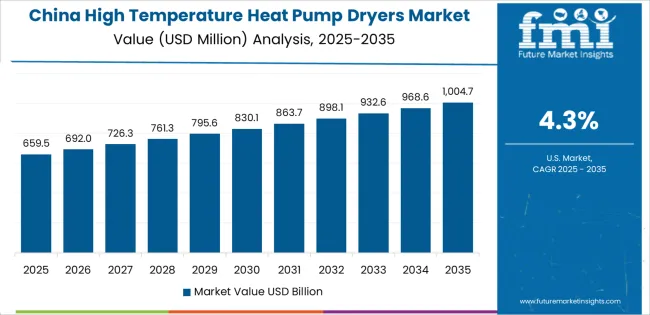
China establishes fastest market growth through aggressive industrial development programs and comprehensive manufacturing expansion, integrating advanced heat pump dryer systems as standard components in power facilities and industrial installations. The country's 4.32% growth rate reflects government initiatives promoting industrial infrastructure and domestic thermal capabilities that mandate the use of energy-efficient thermal systems in power and manufacturing facilities. Growth concentrates in major industrial hubs, including Beijing, Shanghai, and Guangzhou, where industrial development showcases integrated thermal systems that appeal to facility operators seeking energy optimization capabilities and operational applications.
Chinese manufacturers are developing cost-effective thermal solutions that combine domestic production advantages with advanced heat pump features, including enhanced efficiency control and improved performance capabilities. Distribution channels through industrial suppliers and system integrators expand market access, while government support for industrial development supports adoption across diverse power and manufacturing segments.
Strategic Market Indicators:
In Mumbai, Delhi, and Bangalore, power facilities and manufacturing operators are implementing high temperature heat pump dryer systems as standard equipment for energy optimization and operational efficiency applications, driven by increasing government industrial investment and manufacturing modernization programs that emphasize the importance of energy efficiency capabilities. The high temperature heat pump dryers market holds a 4.0% growth rate, supported by government industrial initiatives and manufacturing development programs that promote energy-efficient thermal systems for power and manufacturing facilities. Indian operators are adopting thermal systems that provide consistent energy efficiency and performance features, particularly appealing in urban regions where energy optimization and operational excellence represent critical business requirements.
Market expansion benefits from growing industrial capabilities and international technology partnerships that enable domestic production of advanced thermal systems for power and manufacturing applications. Technology adoption follows patterns established in industrial equipment, where efficiency and performance drive procurement decisions and operational deployment.
Market Intelligence Brief:
Germany's advanced industrial market demonstrates sophisticated heat pump dryer deployment with documented efficiency effectiveness in power applications and manufacturing facilities through integration with existing industrial systems and operational infrastructure. The country leverages engineering expertise in thermal technologies and energy systems integration to maintain a 3.68% growth rate. Industrial centers, including Bavaria, Baden-Württemberg, and North Rhine-Westphalia, showcase premium installations where thermal systems integrate with comprehensive energy platforms and facility management systems to optimize energy efficiency and operational effectiveness.
German manufacturers prioritize system quality and EU compliance in thermal development, creating demand for premium systems with advanced features, including facility integration and energy management systems. The high temperature heat pump dryers market benefits from established industrial infrastructure and a willingness to invest in advanced thermal technologies that provide long-term operational benefits and compliance with international energy standards.
Market Intelligence Brief:
Brazil's market expansion benefits from diverse industrial demand, including manufacturing modernization in São Paulo and Rio de Janeiro, power facility upgrades, and government industrial programs that increasingly incorporate energy-efficient thermal solutions for operational applications. The country maintains a 3.36% growth rate, driven by rising industrial activity and increasing recognition of thermal efficiency benefits, including precise energy control and enhanced operational effectiveness.
Market dynamics focus on cost-effective thermal solutions that balance energy efficiency performance with affordability considerations important to Brazilian industrial operators. Growing manufacturing industrialization creates continued demand for modern thermal systems in new industrial infrastructure and facility modernization projects.
Strategic Market Considerations:
United States establishes market leadership through comprehensive industrial programs and advanced energy infrastructure development, integrating heat pump dryer systems across power and manufacturing applications. The country's 3.04% growth rate reflects established industrial relationships and mature thermal technology adoption that supports widespread use of energy-efficient thermal systems in power and manufacturing facilities. Growth concentrates in major industrial centers, including Texas, California, and the Gulf Coast, where thermal technology showcases mature deployment that appeals to industrial operators seeking proven efficiency capabilities and operational optimization applications.
American industrial providers leverage established distribution networks and comprehensive technical support capabilities, including system design programs and training support that create customer relationships and operational advantages. The high temperature heat pump dryers market benefits from mature regulatory standards and industrial requirements that mandate thermal system use while supporting technology advancement and operational optimization.
Market Intelligence Brief:
United Kingdom's industrial market demonstrates integrated heat pump dryer deployment with documented efficiency effectiveness in power applications and manufacturing facilities through integration with existing industrial systems and operational infrastructure. The country maintains a 2.72% growth rate, supported by energy efficiency programs and operational effectiveness requirements that promote energy-efficient thermal systems for industrial applications. Power facilities across England, Scotland, and Wales showcase systematic installations where thermal systems integrate with comprehensive energy platforms to optimize efficiency and operational outcomes.
UK industrial providers prioritize system reliability and industry compatibility in thermal procurement, creating demand for validated systems with proven efficiency features, including performance monitoring integration and energy management systems. The high temperature heat pump dryers market benefits from established industrial infrastructure and efficiency requirements that support thermal technology adoption and operational effectiveness.
Market Intelligence Brief:
<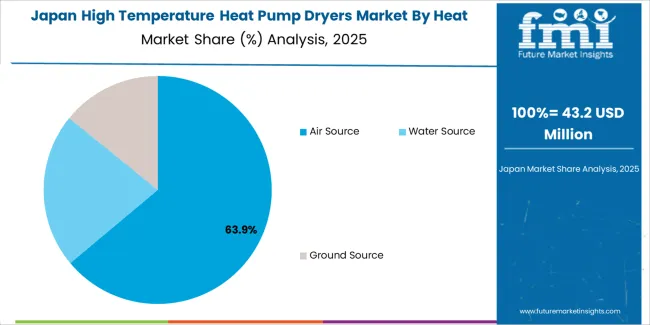
Japan's market growth benefits from precision industrial demand, including advanced manufacturing facilities in Tokyo and Osaka, quality integration, and efficiency enhancement programs that increasingly incorporate thermal solutions for energy applications. The country maintains a 2.4% growth rate, driven by industrial technology advancement and increasing recognition of precision thermal benefits, including accurate energy control and enhanced operational outcomes.
Market dynamics focus on high-precision thermal solutions that meet Japanese quality standards and efficiency effectiveness requirements important to industrial operators. Advanced industrial technology adoption creates continued demand for sophisticated thermal systems in manufacturing facility infrastructure and operational modernization projects.
Strategic Market Considerations:
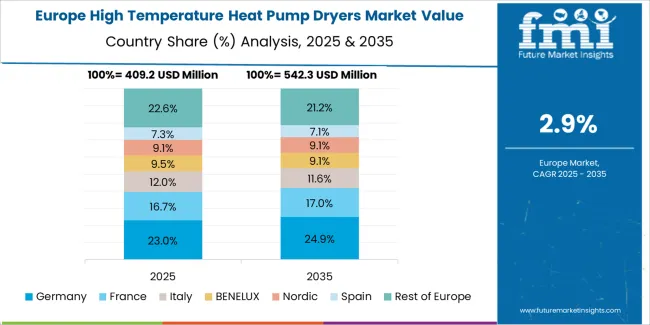
The European high temperature heat pump dryers market is projected to grow from USD 298.7 million in 2025 to USD 410.2 million by 2035, registering a CAGR of 3.2% over the forecast period. Germany is expected to maintain its leadership position with a 41.3% market share in 2025, supported by its advanced industrial infrastructure and major manufacturing centers.
United Kingdom follows with a 26.8% share in 2025, driven by comprehensive energy efficiency programs and industrial development initiatives. France holds a 16.4% share through specialized industrial applications and energy compliance requirements. Italy commands a 9.2% share, while Spain accounts for 6.3% in 2025. The rest of Europe region is anticipated to gain momentum, expanding its collective share from 2.8% to 3.1% by 2035, attributed to increasing industrial adoption in Nordic countries and emerging manufacturing facilities implementing energy modernization programs.
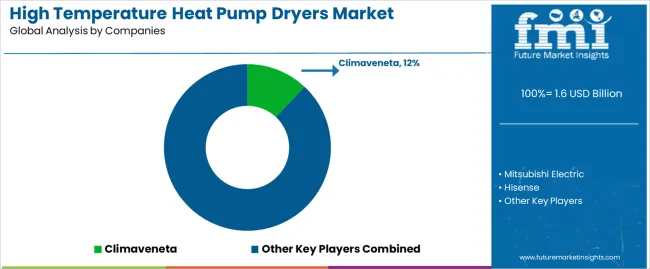
| Stakeholder | What they actually control | Typical strengths | Typical blind spots |
|---|---|---|---|
| Global brands | Distribution reach, broad product catalogs, brand recognition | Wide availability, proven efficiency, multi-region support | Product refresh cycles; customer dependency on brand validation |
| Technology innovators | Heat pump R&D; advanced thermal technologies; enhanced performance properties | Latest technologies first; attractive ROI on efficiency effectiveness | Service density outside core regions; scaling complexity |
| Regional specialists | Local compliance, fast delivery, nearby customer support | "Close to customer" support; pragmatic pricing; local regulations | Technology gaps; talent retention in customer service |
| Full-service providers | Complete thermal programs, system integration, performance monitoring | Lowest operational risk; comprehensive support | Service costs if overpromised; technology obsolescence |
| Niche specialists | Specialized applications, custom systems, industry services | Win premium applications; flexible configurations | Scalability limitations; narrow market focus |
| Item | Value |
|---|---|
| Quantitative Units | USD 1,567 million |
| Heat Source Type | Air Source, Water Source, Ground Source |
| Application | Power Industry, Petrochemical, Environmental Protection, Water Conservancy, Others |
| End Use | Power Plants, Chemical Facilities, Manufacturing Plants, Waste Treatment Facilities, Research Institutions |
| Regions Covered | North America, Latin America, Western Europe, Eastern Europe, East Asia, South Asia Pacific, Middle East & Africa |
| Countries Covered | China, India, Germany, Brazil, United States, United Kingdom, Japan, Canada, France, Australia, and 25+ additional countries |
| Key Companies Profiled | Climaveneta, Mitsubishi Electric, Hisense, Carrier, Johnson Controls, MULTISTACK, Shandong ZKNKT, Shanghai Nuotong New Energy Technology, Wuhu Naimeite Industrial |
| Additional Attributes | Dollar sales by heat source type and application categories, regional adoption trends across East Asia, North America, and Western Europe, competitive landscape with thermal equipment manufacturers and system integrators, industrial operator preferences for thermal effectiveness and energy efficiency, integration with industrial platforms and energy management systems, innovations in heat pump technology and thermal enhancement, and development of advanced thermal solutions with enhanced performance and operational optimization capabilities. |
The global high temperature heat pump dryers market is estimated to be valued at USD 1.6 billion in 2025.
The market size for the high temperature heat pump dryers market is projected to reach USD 2.1 billion by 2035.
The high temperature heat pump dryers market is expected to grow at a 3.2% CAGR between 2025 and 2035.
The key product types in high temperature heat pump dryers market are air source, water source and ground source.
In terms of application, power industry segment to command 35.0% share in the high temperature heat pump dryers market in 2025.






Full Research Suite comprises of:
Market outlook & trends analysis
Interviews & case studies
Strategic recommendations
Vendor profiles & capabilities analysis
5-year forecasts
8 regions and 60+ country-level data splits
Market segment data splits
12 months of continuous data updates
DELIVERED AS:
PDF EXCEL ONLINE
High Purity Tungsten Hexachloride Market Size and Share Forecast Outlook 2025 to 2035
High Purity Nano Aluminum Oxide Powder Market Size and Share Forecast Outlook 2025 to 2035
High Mast Lighting Market Forecast and Outlook 2025 to 2035
High-Protein Pudding Market Forecast and Outlook 2025 to 2035
High Voltage Ceramic Zinc Oxide Surge Arrester Market Size and Share Forecast Outlook 2025 to 2035
High-Power Microwave Source Market Size and Share Forecast Outlook 2025 to 2035
High Performance Epoxy Coating Market Size and Share Forecast Outlook 2025 to 2035
High Molecular Ammonium Polyphosphate Market Size and Share Forecast Outlook 2025 to 2035
High Performance Fluoropolymer Market Size and Share Forecast Outlook 2025 to 2035
High Throughput Screening Market Size and Share Forecast Outlook 2025 to 2035
High Barrier Packaging Films for Pharmaceuticals Market Size and Share Forecast Outlook 2025 to 2035
High Barrier Packaging Films Market Size and Share Forecast Outlook 2025 to 2035
High Purity Carbonyl Iron Powder (CIP) Market Size and Share Forecast Outlook 2025 to 2035
High-Performance Fiber Market Size and Share Forecast Outlook 2025 to 2035
High Frequency Chest-Wall Oscillation Devices Market Size and Share Forecast Outlook 2025 to 2035
High-purity Fluoropolymer Valves Market Size and Share Forecast Outlook 2025 to 2035
High Barrier Pharmaceutical Packaging Films for Blister Market Size and Share Forecast Outlook 2025 to 2035
High Current Ion Implanter Market Size and Share Forecast Outlook 2025 to 2035
High Rate Discharge Test Machine Market Size and Share Forecast Outlook 2025 to 2035
High-precision Confocal Sensor Market Size and Share Forecast Outlook 2025 to 2035

Thank you!
You will receive an email from our Business Development Manager. Please be sure to check your SPAM/JUNK folder too.
Chat With
MaRIA